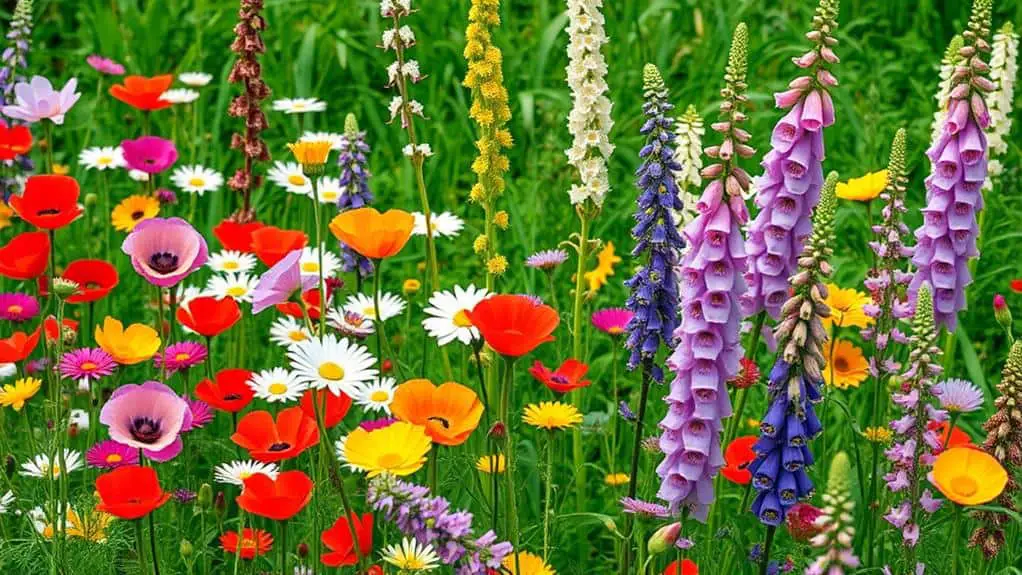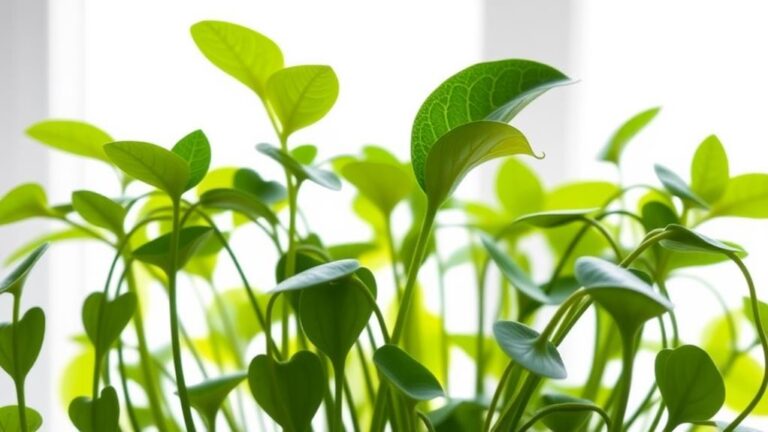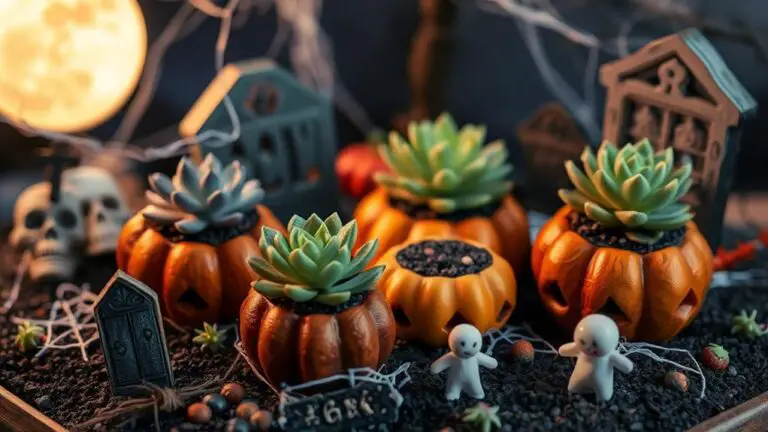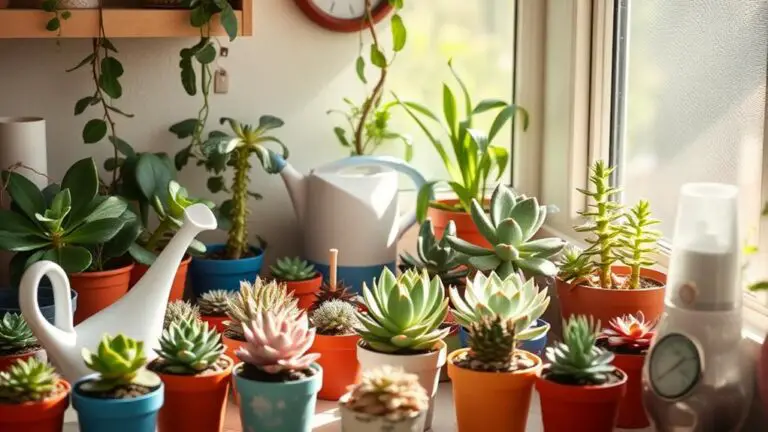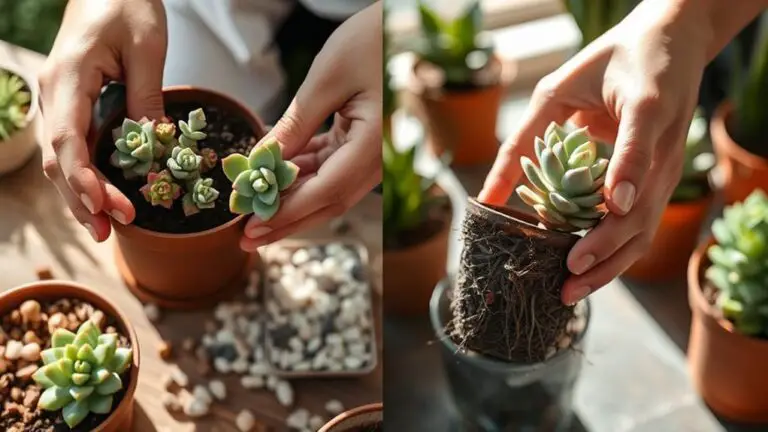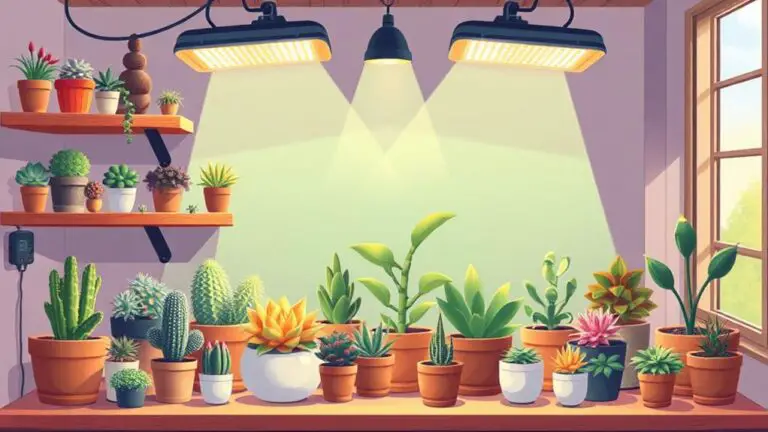Discover 10 Amazing Self-Seeding Flowers for a Perennial Garden
Imagine a garden that flourishes year after year with minimal effort on your part. By incorporating self-seeding flowers, you can achieve just that. Flowers like Allium, Balloon Flower, and Coneflower not only offer stunning visual appeal but also attract essential pollinators. These resilient plants adapt well to various climates and require little maintenance. Curious which other blooms can transform your garden into a perennial paradise? Let's explore the full list of 10 amazing self-seeding flowers that promise to keep your garden vibrant and thriving.
Allium
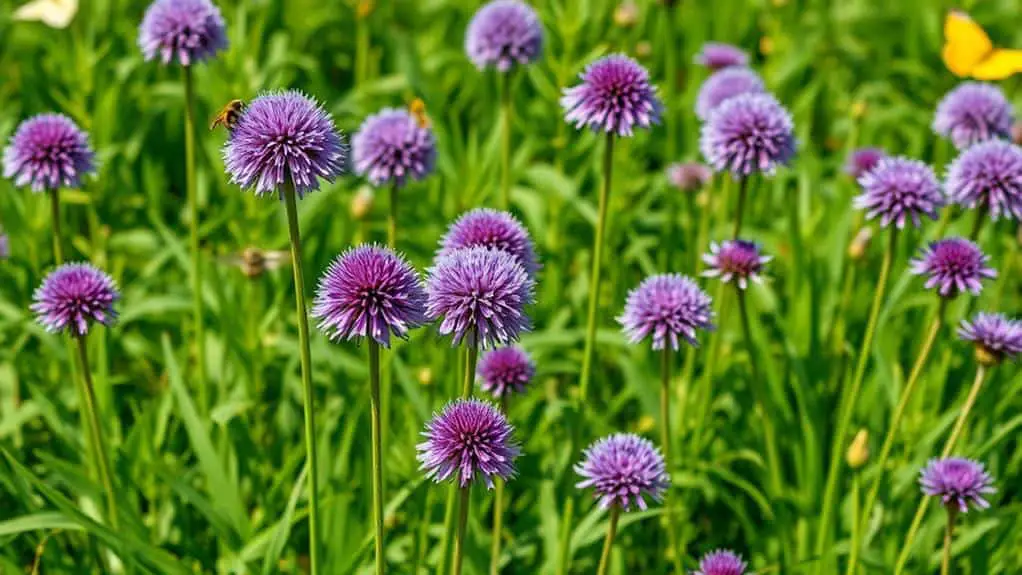
When it comes to adding architectural flair and vibrant color to your perennial garden, ornamental alliums are a fantastic choice. These hardy plants are easy to grow, thriving in USDA Zones 3-10, and they bring a unique touch to any landscape. The popular variety, In Orbit, produces stunning lavender ball-shaped flowers that bloom from spring to fall.
These blooms not only add vibrant color but also make a striking focal point in your garden design.
One of the great things about alliums is their self-seeding nature. When you leave the flower heads intact after blooming, they naturally propagate, ensuring continued growth in subsequent seasons. This self-seeding feature makes them an excellent addition to your perennial garden, as you won't need to replant them every year.
Alliums are readily available for purchase through vendors like Burpee, making it easy for you to get started. Their attractive flowers and architectural shapes make them a standout in any garden.
Balloon Flower

Balloon flowers are a charming addition to your perennial garden, thanks to their unique buds that puff up like balloons before bursting into star-shaped blooms.
To keep them looking their best and prevent them from taking over, you'll need to deadhead regularly.
Not only do these flowers add beauty, but they also attract pollinators, making your garden a buzzing paradise.
Unique Buds and Blooms
Known for their distinctive buds, balloon flowers (Platycodon grandiflorus) add a touch of whimsy to any garden.
These perennial flowers thrive in USDA Zones 3-8, boasting unique balloon-like buds that burst into stunning star-shaped blooms. You'll find them in a variety of colors like blue, pink, and white, providing vibrant visual interest throughout the growing season.
Balloon flowers are perfect for adding charm to your garden beds and borders. They usually grow to heights of 1-2 feet and can spread just as wide.
For the best results, plant them in areas with full sun to partial shade and guarantee the soil is well-drained. While they're relatively easy to grow, be prepared for some aggressive self-seeding. Deadheading the spent blooms can help control this.
Here's why you should consider balloon flowers:
- Unique Buds: Their balloon-like buds are a fascinating sight before they open.
- Perennial Beauty: Enjoy their blooms year after year without replanting.
- Versatile Growth: Suitable for various garden conditions, from full sun to partial shade.
- Vibrant Colors: Their blooms come in lovely shades of blue, pink, and white.
With these features, balloon flowers can be a delightful addition to your garden.
Maintenance and Care
To keep your balloon flowers looking their best, proper maintenance and care are key. Start by planting them in well-drained soil and making sure they receive full sun to partial shade. These conditions help your balloon flowers thrive and contribute to their robust growth.
Since balloon flowers can self-seed and expand naturally in your garden, it's essential to manage their spread. Regular deadheading, or removing spent blooms, will help control their aggressive nature. This simple step keeps your perennial garden looking tidy and prevents unwanted seedlings from taking over.
Balloon flowers can grow between 1 to 3 feet tall and 1 to 2 feet wide. These dimensions make them a substantial presence in your garden. To guarantee they reach their full potential, water them regularly but avoid overwatering, as they prefer well-drained soil.
These hardy plants are suitable for USDA Zones 3-8, making them versatile for many gardeners. If you give them the right care, they'll reward you with their unique balloon-like buds that burst into star-shaped flowers from late spring through summer.
Pollinator Attraction
With their vibrant star-shaped blooms, balloon flowers (Platycodon grandiflorus) are a magnet for pollinators like bees and butterflies.
These flowers open from unique balloon-like buds, creating a visual treat that draws in pollinators throughout the growing season. By deadheading the spent flowers, you can extend their blooming period, ensuring a consistent nectar source for your garden's pollinators.
Balloon flowers thrive in Zones 3-8, making them suitable for various climates. Their self-seeding nature contributes to a naturalized garden environment, creating sustainable habitats that benefit pollinators year after year.
Here's how balloon flowers can enhance your pollinator-friendly perennial garden:
- Continuous Blooming: Deadhead regularly to keep the flowers blooming longer, providing ongoing nectar for bees and butterflies.
- Self-Seeding: Allow some flowers to go to seed, creating a sustainable cycle that supports pollinators annually.
- Diverse Habitats: Plant in different garden areas to create varied habitats for different pollinator species.
- Climate Adaptability: Suitable for Zones 3-8, making it accessible for many gardeners aiming to support local pollinators.
Borage
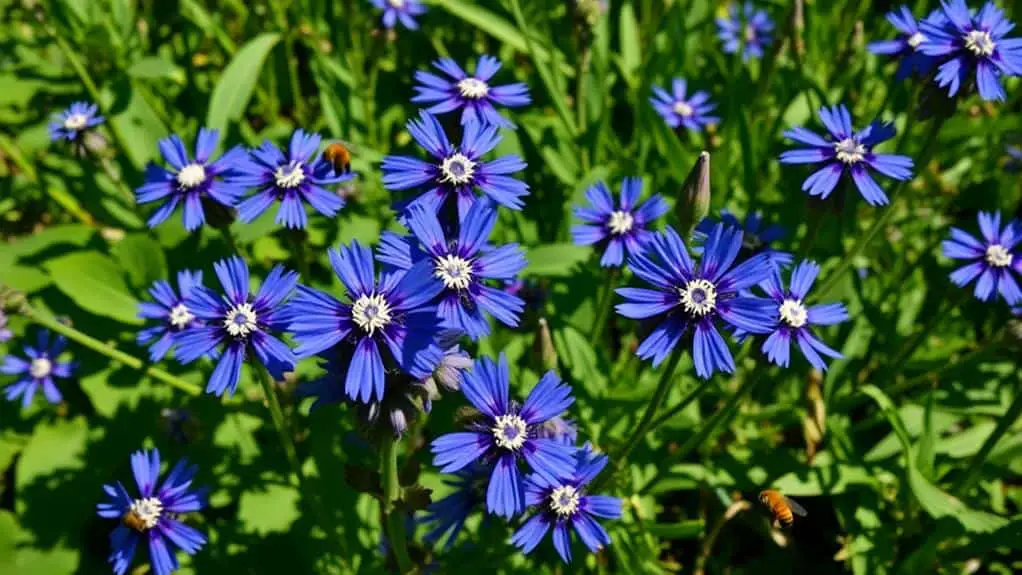
Borage (Borago officinalis) is a standout in any perennial garden, thanks to its striking bright blue star-shaped flowers. This plant doesn't just look good; it's also incredibly practical. Borage can thrive in USDA Zones 3-10, making it a versatile option for many gardeners. Its leaves are edible and can be added to salads and drinks, adding a unique twist to your culinary creations.
One of the best things about borage is that it's low-maintenance. It naturalizes easily in gardens without becoming invasive, so you won't have to worry about it taking over. Plus, borage is a self-seeding plant, meaning it will return year after year with minimal effort on your part. This makes it a fantastic choice for a perennial garden.
| Feature | Detail |
|---|---|
| Flower Color | Bright blue |
| USDA Zones | 3-10 |
| Edible Parts | Leaves |
| Maintenance Level | Low |
| Pollinator Attraction | Bees and butterflies |
Borage also attracts pollinators such as bees and butterflies, enhancing the biodiversity of your garden. By planting borage, you're not only beautifying your space but also supporting essential garden helpers. So go ahead, add this amazing plant to your garden and enjoy its benefits year after year!
Clary Sage

Clary sage, with its clusters of pink, violet, and white flowers, thrives in well-drained soil and brings color to your garden from USDA Zones 5-9.
This biennial plant not only adds beauty but also self-seeds, ensuring it returns year after year.
Plus, its camphor flavor can enhance your cooking, making it a useful and attractive addition to your garden beds.
Bloom Characteristics
Often admired for its stunning visual appeal, Salvia sclarea, better known as clary sage, showcases a vibrant array of pink, violet, and white flowers that bloom atop tall, striking spikes. These flowers typically bloom in late spring to early summer, creating a breathtaking display in your garden.
The tall spikes with their colorful flowers look magnificent and effortlessly draw the attention of pollinators like bees and butterflies.
One of the most exciting aspects of clary sage is its self-seeding capability. Letting the seed heads mature on the plant guarantees that new clary sage plants will return year after year, making it an excellent perennial option for your garden.
Plus, the plant's attractive foliage adds a lovely touch of green even before the flowers appear.
Here's what makes clary sage a favorite among gardeners:
- Bloom Time: Flowers bloom in late spring to early summer.
- Height: Can grow up to 3 feet tall.
- Soil Preference: Thrives in well-drained soil.
- Zones: Suitable for USDA Zones 5-9.
With its tall spikes and vibrant colors, clary sage not only beautifies your garden but also supports pollinators. Letting it self-seed guarantees you'll enjoy its beauty for many seasons to come.
Culinary Uses**
Beyond its ornamental appeal, Salvia sclarea boasts a variety of culinary applications that make it a versatile addition to your garden. This self-seeding plant isn't just pretty to look at; it's packed with flavors that can enhance many culinary dishes. Clary sage has a unique camphor flavor, making it a favorite in Mediterranean cuisine.
You can use the leaves and flowers to flavor vinegars and oils, adding an aromatic depth to your cooking. Clary sage blooms are edible flowers, perfect for garnishing salads or sweetening desserts. They add both color and taste to your dishes, making your meals visually appealing and delicious.
Moreover, clary sage is rich in essential oils. These oils can be extracted and used for flavoring or even in aromatherapy, offering both culinary and health benefits. Infuse the leaves into herbal teas to enjoy their soothing aroma and flavor.
Traditionally, clary sage has been used in the production of absinthe and vermouth, showcasing its versatility in various food and beverage recipes.
Columbine
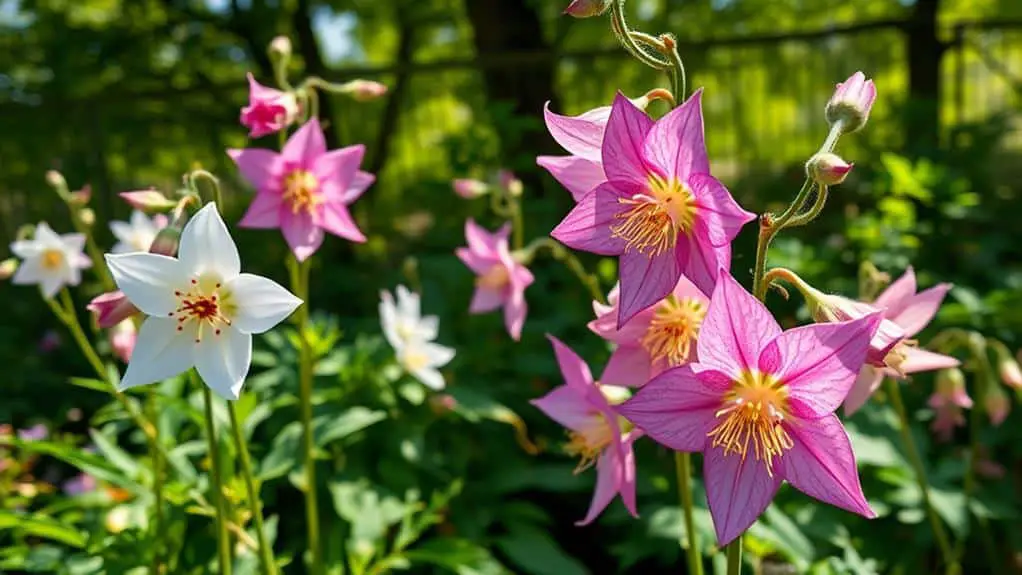
Columbines (Aquilegia spp.) are delicate and polite self-seeders that bring unique, heart-shaped flowers to your garden, thriving in USDA Zones 3-8.
These charming flowers, typically growing 1-3 feet tall and 1-2 feet wide, fit well in various garden spaces. Columbines are versatile and can flourish in full sun to partial shade. They adapt to a range of soil types but do best in well-drained conditions, ensuring healthy growth.
One of the most delightful aspects of columbines is their self-seeding nature. You can count on them to return year after year, creating a naturally vibrant garden without much effort.
Here's how they can enhance your garden:
- Heart-shaped flowers: Columbines offer a distinctive look, adding a touch of uniqueness to your garden.
- Attract pollinators: Bees and butterflies love columbines, which helps boost local biodiversity.
- Low maintenance: Their self-seeding ability means less work for you while maintaining a beautiful garden.
- Adaptability: They thrive in various light conditions and soil types, making them a versatile choice.
Coneflower
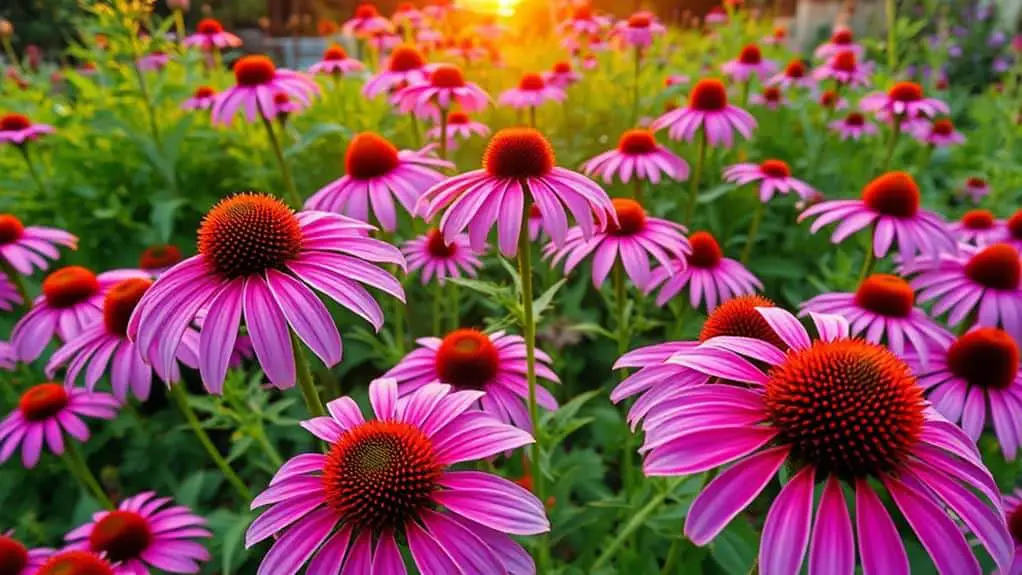
Coneflowers are a fantastic choice for your perennial garden, thriving in USDA Zones 3-9 with their bright, daisy-like blooms that can reach up to 5 feet tall.
They attract bees, butterflies, and songbirds, adding life to your garden and helping pollinate other plants.
These low-maintenance flowers easily self-seed, ensuring you'll enjoy their vibrant display year after year without the hassle of replanting.
Growth Habits Overview
Thriving in USDA Zones 3-9, Echinacea spp., commonly known as coneflowers, often bring a resilient and vibrant touch to any perennial garden. These hardy perennials are adaptable to various climates, making them a great choice for many gardeners.
Coneflowers typically grow between 2 to 5 feet tall and can spread from 1 to 3 feet wide, giving them a robust presence in your garden. They prefer full sun to partial shade and are drought-tolerant once established, which makes them low-maintenance.
Their striking bright petals surround a prominent central cone, attracting a variety of pollinators and supporting garden sustainability.
One of the best features of coneflowers is their self-seeding capability. When you let the flowers mature, they can produce new plants year after year. This self-seeding trait guarantees that your garden remains full and vibrant with minimal effort.
Here are some key points to remember:
- Hardy Perennials: Adaptable to various climates, thriving in USDA Zones 3-9.
- Full Sun: Prefers full sun but can tolerate partial shade.
- Low-Maintenance: Drought-tolerant and easy to care for once established.
- Garden Sustainability: Self-seeding capability supports a sustainable garden.
Pollinator Attraction Benefits
While understanding the growth habits of coneflowers is important, appreciating their role in attracting pollinators can greatly enrich your gardening experience. Coneflowers, with their vibrant petals and prominent central cones, are like magnets for bees and butterflies. These pollinators are vital for a healthy ecosystem, and your garden can become a haven for them.
The nectar-rich blooms of coneflowers provide essential food resources, especially during the late summer months when other flowers might be scarce. This continuous source of nourishment supports the health of pollinator populations, ensuring they thrive and help your garden flourish.
Plus, coneflowers are drought-tolerant once established, making them a low-maintenance choice that still does wonders for the environment.
Because they're self-seeding, coneflowers will naturally spread throughout your garden, creating larger patches each year. This not only enhances their visual appeal but also increases the garden's attractiveness to pollinators.
As a perennial, coneflowers return year after year, providing consistent beauty and support for pollinators over time. By planting coneflowers, you're creating a sustainable, vibrant, and pollinator-friendly space that's easy to maintain and incredibly rewarding.
Self-Seeding Process**
The self-seeding process of coneflowers is a marvel of nature's efficiency, guaranteeing these vibrant plants continue to grace your garden year after year without the need for replanting.
These hardy perennials produce seeds from late summer to early fall. Once the flowers fade, the seeds are dispersed by wind, birds, and gravity, leading to new plants in the next season.
To make the most of coneflowers' self-seeding ability, follow these steps:
- Leave Spent Flower Heads: Allow the flower heads to dry on the plant. This provides food for birds and guarantees seeds drop naturally.
- Monitor Soil and Location: Coneflowers thrive in various soil types and are drought-tolerant, making them low-maintenance. Guarantee they're in a sunny spot for best results.
- Avoid Over-Mulching: Too much mulch can smother seeds. Keep the area lightly covered to help seeds find their way to the soil.
- Watch for New Growth: In the next season, look for young coneflower plants and enjoy the continuity of your garden's beauty.
Hollyhock
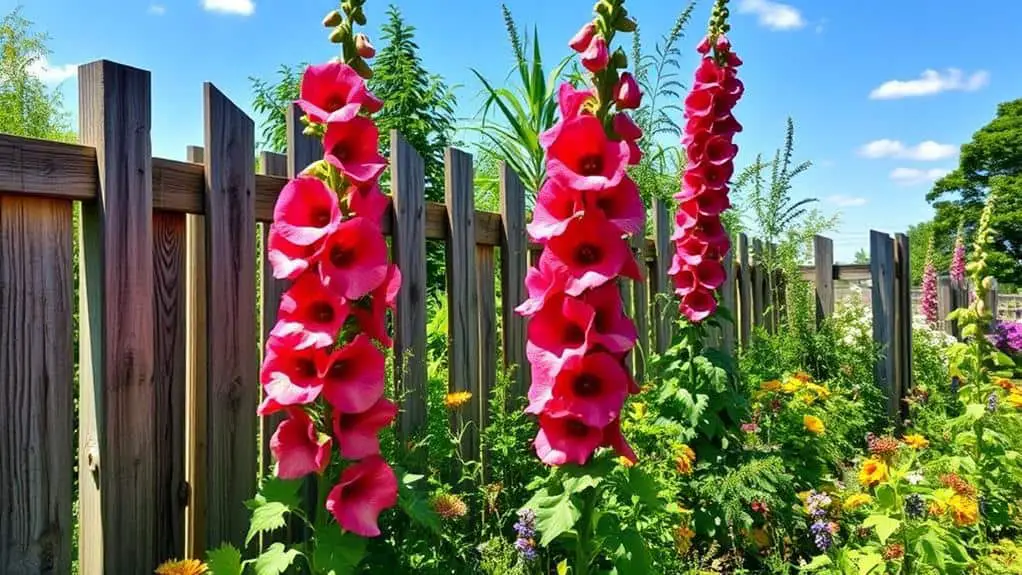
Hollyhocks (Alcea spp.) are a stunning addition to any garden, standing tall with their vibrant spikes of flowers. These plants are biennial to perennial, meaning they'll come back year after year with little effort on your part.
Hollyhocks can grow up to 8 feet tall, making a bold statement in your garden. They thrive in USDA Zones 3-9, and you'll see their colorful spikes of blooms from mid-summer to fall.
One of the best things about hollyhocks is their self-seeding nature. Once you plant them, they'll drop seeds from spent flowers, ensuring a lush, cottage-garden feel season after season. This makes them perfect for gardeners who love a low-maintenance yet beautiful landscape.
Hollyhocks attract bees, butterflies, and other pollinators, making your garden a buzzing, lively place.
To keep your hollyhocks thriving, you can collect seeds from the dried flowers and sow them where you want new plants the following year. This helps maintain a vibrant display without much work.
With their tall, colorful spikes and ability to self-seed, hollyhocks are an excellent choice for any perennial garden.
Lavender

Opting for lavender in your garden can bring both beauty and utility. This self-seeding perennial thrives in well-drained soil and full sun, making it a low-maintenance choice perfect for busy gardeners.
Lavender is hardy in USDA Zones 5-9, so it can withstand different climates while still producing its signature fragrant blooms. These purple flowers not only look lovely but also attract pollinators like bees and butterflies, enhancing the health of your garden.
To make the most of lavender, keep these tips in mind:
- Choose a sunny spot: Lavender needs full sun to grow well. Make sure it gets at least 6-8 hours of sunlight each day.
- Ensure good drainage: Plant lavender in well-drained soil to prevent root rot. If your soil is heavy, consider adding sand or gravel to improve drainage.
- Prune regularly: Trim your lavender plants after they bloom to encourage more growth and maintain their shape.
- Harvest for multiple uses: You can use lavender blooms in culinary recipes, aromatherapy, or natural skincare products.
Delphinium

Many gardeners choose Delphinium spp. for their perennial gardens due to their strikingly tall spikes adorned with vibrant flowers. These plants are a favorite because they're hardy in USDA Zones 3-9, making them perfect for a wide range of climates.
Delphiniums thrive in full sun to partial shade and prefer well-drained soil. This means you'll need to plant them in a spot where water doesn't pool.
Delphiniums are short-lived perennials, but don't worry—they're self-seeding. This means they'll come back year after year, providing continuous color to your garden. One beautiful cultivar to contemplate is the Magic Fountains, which features deep royal purple flowers. This rich hue can really make your garden pop.
These vibrant flowers aren't just pretty to look at; they also attract pollinators like bees and butterflies. By planting delphiniums, you're not only enhancing the beauty of your garden but also supporting local biodiversity.
Gladiolus
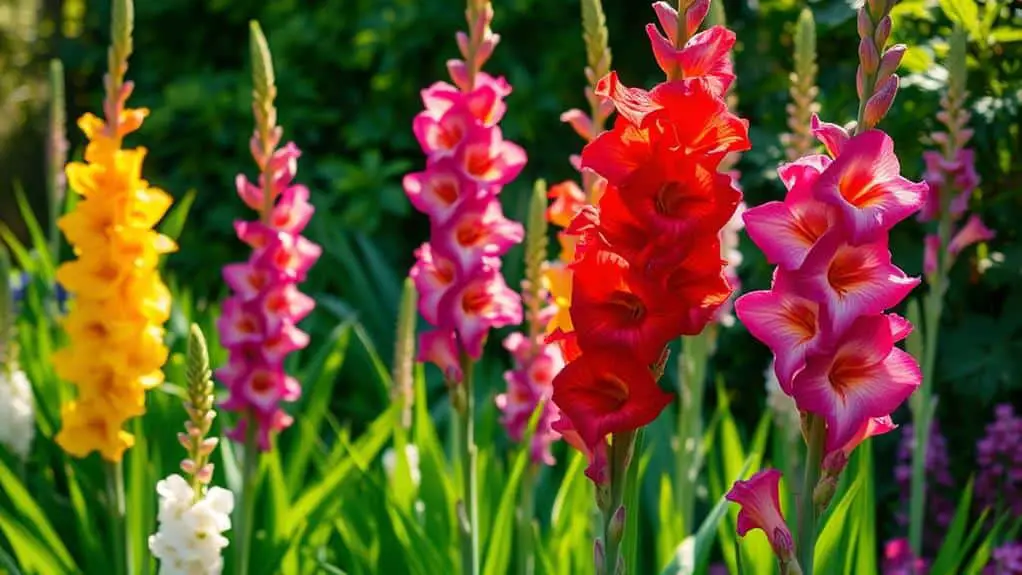
Gladiolus, often referred to as sword lilies, are characterized by their striking sword-shaped leaves and vibrant flowers, making them an excellent choice for cut flower arrangements.
These beautiful plants aren't only eye-catching but also practical for your garden. They thrive in full sun and well-drained soil, ensuring they grow strong and healthy.
One of the best features of gladiolus is their ability to self-seed, which means they can reliably return year after year in Zones 8-10.
If you live in a colder climate, don't worry—hardy cultivars can survive in Zone 3. You can find seeds for these stunning flowers from various vendors like Eden Brothers.
Here's why you should consider adding gladiolus to your garden:
- Vibrant Flowers: They bloom in a variety of colors and heights, adding diversity to your garden.
- Self-Seeding: These flowers can come back on their own, saving you time and effort.
- Cut Flower Arrangements: Perfect for bringing the beauty of your garden indoors.
- Adaptability: With hardy cultivars, even colder climates can enjoy these flowers.
Frequently Asked Questions
What Is the Easiest Perennial Flower to Grow From Seed?
You'll find Columbine (Aquilegia spp.) to be the easiest perennial flower to grow from seed. It thrives in USDA Zones 3-8 and self-seeds effectively once established, making it perfect for a low-maintenance garden.
What Is the Flower That Reseeds Itself?
The common poppy is a fantastic flower that reseeds itself. You'll love how it disperses seeds naturally, ensuring vibrant blooms year after year with minimal effort. It thrives in various climates and attracts beneficial pollinators.
What Is the Fastest Growing Perennial Flower?
The fastest growing perennial flower is the Daylily. You'll see it reach full height in just 6 to 12 weeks after planting. Its vibrant summer blooms make it a favorite for quick, beautiful garden results.
What Is the Difference Between Perennials and Self Seeding Plants?
Perennials live for three years or more, returning each season. Self-seeding plants, whether annuals or perennials, naturally disperse seeds to grow new plants without replanting. Not all perennials self-seed, but self-seeders reduce garden maintenance.
Conclusion
By adding these self-seeding flowers to your garden, you'll create a stunning, low-maintenance paradise that returns year after year. With varieties like Allium and Balloon Flower, your garden will attract bees and butterflies, boosting pollination. These hardy plants thrive in different climates and need minimal care, making gardening easier for you. Embrace the beauty and benefits of self-seeding flowers, and watch your garden transform into a colorful, vibrant sanctuary. You've got this—happy gardening!

